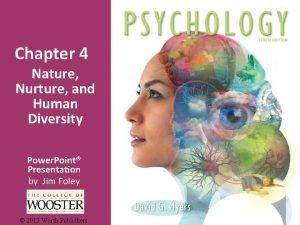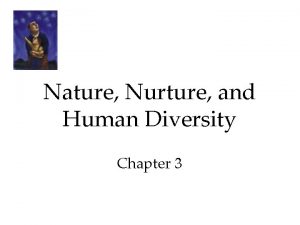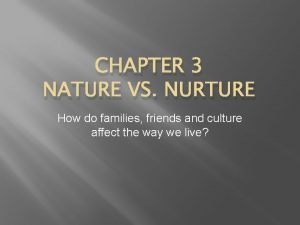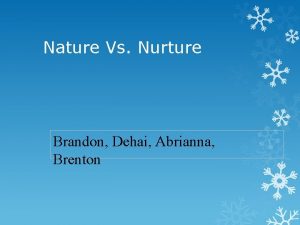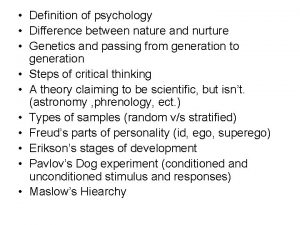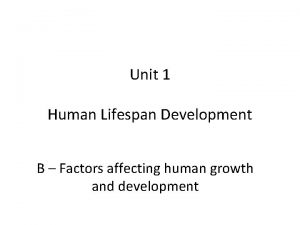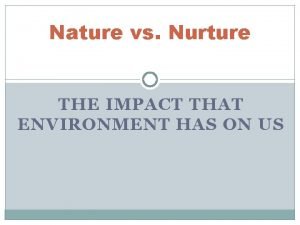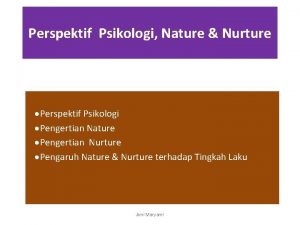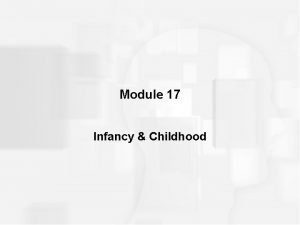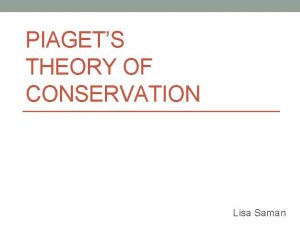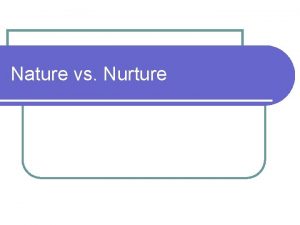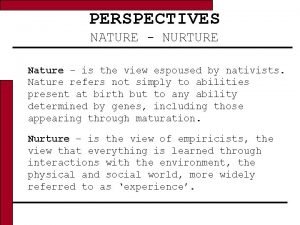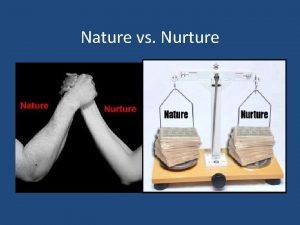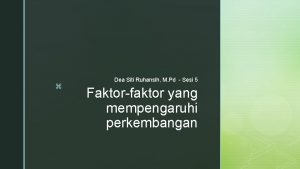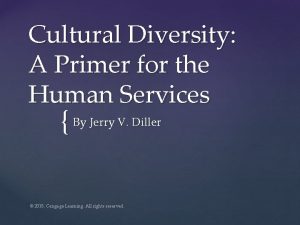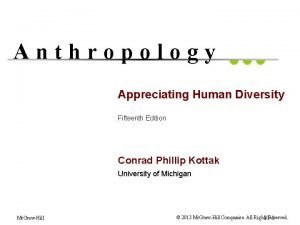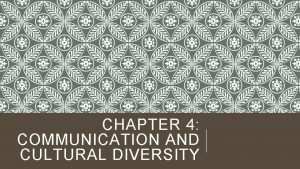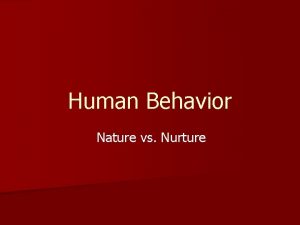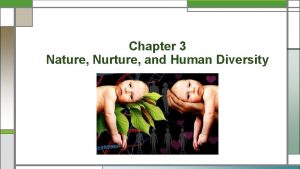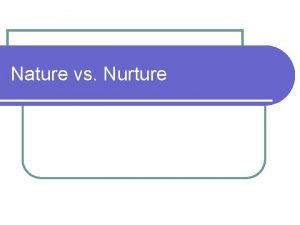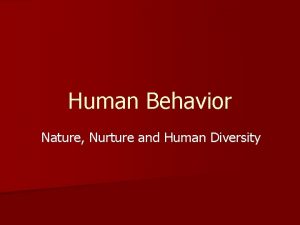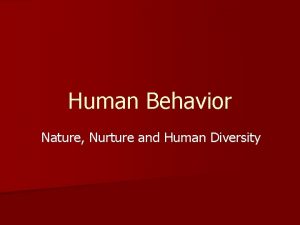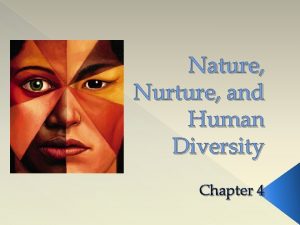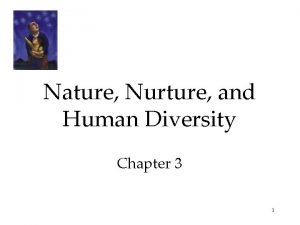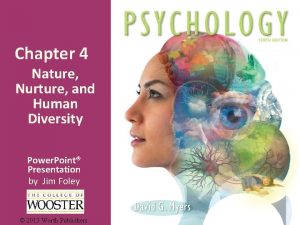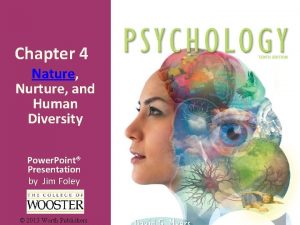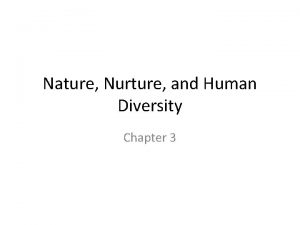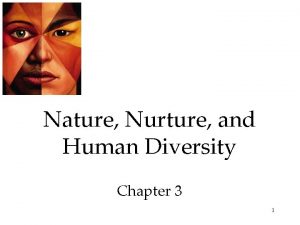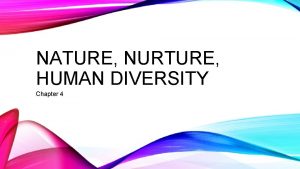Chapter 4 Nature Nurture and Human Diversity Overview




























































- Slides: 60

Chapter 4 Nature, Nurture, and Human Diversity

Overview: Nature/Nurture/Diversity Questions § How do we explain traits that all humans may have in common? § How do we explain the origins of diversity, the source of differences in the traits: • between genders? • among cultures? • among individuals? § But first, how do we investigate these issues?

• Genetics – Branch of biology that deals with the mechanisms of heredity. • Heredity – Transmission of genetic information from one generation to the next • Behavior Genetics – Study of how variation in genes affects variation in behavior

Behavior Genetics: Predicting Individual Differences The topics in the text: 1. genes 2. twin and adoption studies 3. temperament and heredity 4. molecular genetics 5. heritability 6. gene/environment interaction Behavior geneticists study how heredity and environment contribute to human differences. Let’s start by looking at GENES.

GENES: The Building Blocks of Heredity and Development Genes are parts of DNA molecules, which are found in chromosomes in the nuclei of cells. DNA (Deoxyribonucleic Acid)

Chromosomes are made of DNA, which are made of genes. Chromosome: threadlike structure made largely of DNA molecules DNA: a spiraling, complex molecule containing genes }

DNA • Watson and Crick (1953) • Identified the molecule’s structure – Double helix – 4 -letter alphabet code: A, G, T, C= 4 Nucleotides – Mechanism of replication discovered – DNA = an amazing little replicator • Nobel Prize (1962) "for their discoveries concerning the molecular structure of nucleic acids and its significance for information transfer in living material"

Chromosomes and Inheritance § The human genome includes 46 chromosomes in 23 sets matched sets; each chromosome has the same gene locations. § This includes the X and Y chromosomes, not a matched set in males, who are missing some genes on the Y. § A biological parent donates half his/her set of chromosomes to his/her offspring. § We received half a set of chromosomes from each biological parent.

The Human Genome: 20, 000 to 25, 000 Genes § Human genomes are so nearly identical that we can speak of one universal human genome. § Yet tiny genetic differences make a difference. If there is a: §. 001 percent difference in genome, your DNA would not match the crime scene/you are not the baby’s father. § 0. 5 to 4 percent difference in genome, you may be a chimpanzee. § 50 percent difference in genome, you may be a banana. The genome: an organism’s entire collection of genes

How Genes Work § Genes are not blueprints; they are molecules. § These molecules have the ability to direct the assembly of proteins that build the body. § This genetic protein assembly can be turned on and off by the environment, or by other genes. § Any trait we see is a result of the complex interactions of many genes and countless other molecules.

Next step for behavior geneticists: Controlling Variables Can we design an experiment to keep genes constant and vary the environment and see what happens? Or vary the genes in the same environment?

Fraternal and Identical Twins Fraternal “twins” from separate eggs are not any more genetically alike than other siblings. Identical twin: Same sex only Fraternal twin: Same or opposite sex Twin and Adoption Studies To assess the impact of nature and nurture, how do we examine how genes make a difference within the same environment? § study traits of siblings vs. identical twins § see if the siblings vary more than twins

Identical vs. Fraternal Twins Studies of twins in adulthood show that identical twins are more alike than fraternal twins in: § personality traits such as extraversion (sociability) and neuroticism (emotional instability). § behaviors/outcomes such as the rate of divorce. § abilities such as overall Intelligence test scores. Twin and Adoption Studies How do we find out how the same genes express themselves in different environments? We can study the traits of identical twins as they grow up, or if they were raised separately (e. g. , the Minnesota Twin Family Study).

Studies of Identical Twins Raised Apart Critiques of Twin Studies Similarities found in identical twins despite 1. In the more recent years of the Minnesota Twin Family Study, twins being raised in have known about each other and different homes: may influence each other to be more similar. § personality, styles of happen; some thinking and relating 2. Coincidences randomly chosen pairs of people will have similar traits, including even § abilities/intelligence spouses, children, and dogs with test scores identical names. § attitudes 3. Environments may be similar; adoptive families tend to be more § interests, tastes similar than randomly selected families in education, income, and § specific fears values. § brain waves, heart BUT none of these factors explains, better than the genetic explanation, rate why fraternal twins have more differences than identical twins.

Searching for Parenting Effects: Biological vs. Adoptive Relatives Studies have been performed with adopted children for whom the biological relatives are known. Findings: Adopted children seem to be more similar to their genetic relatives than their environmental/nurture relatives. Given the evidence of genetic impact on how a person turns out, does parenting/nurture make any difference? Does the home environment have any impact?

Parenting Does Matter Despite the strong impact of genetics on personality, parenting has an influence on: § religious beliefs § values § manners § attitudes § politics § habits

If parenting has an influence, why are siblings so different? § Siblings only share half their genes. § Genetic differences become amplified as people react to them differently. § Siblings are raised in slightly different families; the youngest has more older siblings and has older (wiser? more tired? ) parents.

Temperament is another difference not caused by parenting. § From infancy into adulthood, most people do not seem to change temperament (defined as a person’s general level and style of emotional reactivity). § According to some researchers, three general types of temperament appear in infancy: • “easy” • “difficult” • “slow to warm up”

Molecular Genetics § Molecular genetics is the study of the molecular structure and function of genes. § Molecular genetics might help us see exactly how specific genes have an influence on behavior. § Genetic tests can reveal which people are at risk for many physical diseases, and may soon identify people at risk of mental health disorders. § Ethical conundrum: should people use genetic tests to select sperm, eggs, and even embryos?

Heritability § When you see a variation of some trait within a population, the heritability of that trait is the amount of variation in the population that is explained by genetic factors. § This DOES NOT tell us the proportion that genes contribute to the trait for any one person. § The heritability of a trait also does not tell us whether genetics explain differences between groups/populations. Clarifying Heritability § If five unrelated people had nearly identical upbringing, but differed in a trait such as shyness, then the heritability of this trait for them is close to 100 percent. § Nurture may have influenced how shy they are, but because it influenced them all in the same way, any differences are almost certainly caused by genes.

Nature and nurture working together Interaction of Genes and Environment § Some traits, such as the overall design of our bodies, are set by genes. § Other traits, such as physical and mental abilities, develop in response to experience. How does the interaction of genes and environment work? § Genetic traits influence the social environment, which in turn affects behavior.

How does the interaction of genes and environment work? § Self-regulation: genes turn each other on and off in response to environmental conditions § Epigenetics: the environment acts on the surface of genes to alter their activity Example of selfregulation in animals: shortened daylight triggers animals to change fur color or to hibernate Example of selfregulation in humans: obesity in adults can turn off weight regulation genes in offspring

The Human Approach to Nature and Nurture § The trait of being adaptable is built into the human genome. Paradox: our genes allow us not to be tied so much to our genes! § We have minds which allow us to change our behavior in response to the environment to a greater degree than other species. § We even shape our environments to suit our nature. § Humans can adapt to a variety of climates, diets, lifestyles, and skills.

Evolutionary Psychology: Understanding Human Nature Some topics: § Natural selection and adaptation § Evolutionary success may help explain similarities § An evolutionary explanation of human sexuality Evolutionary psychology is the study of how evolutionary principles help explain the origin and function of the human mind, traits, and behaviors. We have been talking so far about human differences; we may now seek insight in the ways in which humans are alike. 24

Evolutionary Psychology: Natural Selection: How it Works Begin with a species’ genome, which contains a variety of versions of genes that shape traits. Conditions make it difficult for individuals with some traits (some versions of those genes) to survive long enough to reproduce. Other individuals thus have their traits and genes “selected” to spread in the population.

Artificial Selection The Domesticated Silver Foxes § Dmitri Balyaev and Lyudmila Trut spent 40 years selecting the most gentle, friendly, and tame foxes from a fox population, and having those reproduce. § As a result, they were able to shape avoidant and aggressive creatures into social ones, just as wolves were once shaped into dogs. 26

How might evolution have shaped the human species? Example: § Why does “stranger anxiety” develop between the ages of 9 and 13 months? Hint: in evolutionary/survival terms, humans are learning to walk at that time. Possible explanation: infants who used their new ability to walk by walking away from family and toward a lion might not have survived to reproduce as well as those who decided to cling to parents around the time they learned to walk. 27

Evolutionary Psychology’s Explanation of Phobias § Why do people so easily acquire a phobia of snakes? § An evolutionary psychologist would note that snakes are often poisonous… so those who more readily learned to fear them were more likely to survive and reproduce. § Can we apply the same logic to phobias about heights? enclosed spaces? clowns? 28

A Possible Human Genetic Legacy: “Illogical” Moral Reasoning It might be “logical” to kill one innocent person if it would enable five other innocent people to live. Research shows that most people can imagine letting the one person die, but cannot picture killing the person themselves. Why would it be instinctual not to kill unless we are directly threatened?

Male and Female Differences: Focusing on Mating Preferences First issue: quantity (of mating) § Generally, men think more than women about sex, and men are more likely to think that casual sex is acceptable. § Why might natural selection have resulted in greater male promiscuity? An evolutionary psychologist’s answer: Men who had the trait of promiscuity were more likely to have their genes continue, and even spread, in the next generation. And there is little cost to spreading extra genes. For women, a trait of promiscuity would not greatly increase the number of babies, and it would have greater survival costs (pregnancy, once a life-threatening condition).

Possible Evolutionary Strategies in Seeking Partners Q: How would evolutionary psychology explain why males and females have different preferences for sexual partners? Men seek women with a fuller figure… to make sure they are not too young or too old to have children? Women seek males with loyal behavior and physical/social power and resources… in order to ensure the survival of the mother’s offspring?

Critiquing the Evolutionary Perspective on Gender Differences in Sexuality Are males and female really so different in their mating choices? Differences are less in cultures that move to gender equality. Isn’t much of gender behavior a function of culture? Yes, as we’ll see later in this lesson. How do you explain homosexuality? Guesses such as population control or misplaced instincts are unproven and seem forced. Does evolutionary psychology really tell us anything useful? See next slide…

Critiquing Evolutionary Psychology “You’re just taking current reality and constructing a way you could have predicted it. ” This is hindsight reasoning and unscientific. Response: yes, but there are predictions made about future behavior using this reasoning. “You’re attributing too much to genes rather than the human ability to make choices about social behavior. ” Response: yes, but our evolutionary past does not prevent our ability to act differently; “is” does not equal “ought. ”

Nature/Nurture From Genes to the Role of Environment § How environment/experience affects brain development § Forces guiding the course of development: § parents § peers § culture Our starting picture Our environment gives us our experiences.

Experience and Brain Development Rats living in an “enriched” environment (more social interaction and physical play) experienced a greater growth in brain size and complexity than those rats living in an “impoverished” environment.

Brain Development Means Growth AND Pruning § To make our well-used brain pathways work better, the unused connections are “pruned” away. § This means that if certain abilities are not used, they will fade.

Impact of Experience/Nurture on Brain Development The Process Continues into Adulthood Repeated practice at a finger-tapping task begins to activate a [slightly] larger group of motor neurons.

Is parenting a powerful environmental influence on development? § Generally, environmental influences, including parenting, account for about 10 percent of temperament, although a much higher percentage for other features such as values. § Non-abusive “average” parents should ease off on both the blame and the credit they assume for how their kids turn out. Where this percentage increases: “extreme” parenting, including severe neglect and abuse

Peer Influence § The degree of peer influence is hard to trace. Apparent conformity (the whole group smokes) could be a selection effect (they get together because they want to be with others who like to smoke). § Interaction with peers can teach new social skills. § Parents may try to have indirect influence by selecting a child’s peers, such as by selecting a school or neighborhood. However, ultimately, most children self-select their peers.

Parents vs. Peers Battling over non-genetic influence Parents have more influence on: Education and career path Cooperation Self-discipline Responsibility Charitableness Religion Style of interaction with authority figures Peers have more influence on: Learning cooperation skills Learning the path to popularity Choice of music and other recreation Choice of clothing and other cultural choices Good and bad habits

Culture Influences on Development The nature of culture Variation across cultures Examples of cultural variation over time § Culture refers to the patterns of ideas, attitudes, values, lifestyle habits, and traditions shared by a group of people and passed on to future generations. § Culture is not just an influence on our nature, but it is also part of our nature. Humans form not only relationships, but culture. § Each culture has norms--standards for acceptable, expected behavior. § Example: “Eww, you wear your shoes from outdoors right into the house? ” § Culture shock: feeling lost about what behaviors are appropriate Cultural variation can occur even within one culture: § language changes in vocabulary and pronunciation § the pace of life quickens § gender equality increases. § people sleep less, socialize in person less, stare at screens more § people marry more for love, but then expect more romance These cultural changes occur too fast to be rooted in genetic change.

Culture Influences on Development Culture and the self: individualism and collectivism § Individualist cultures value independence. They promote personal ideals, strengths, and goals, pursued in competition with others, leading to individual achievement and finding a unique identity. § Collectivist cultures value interdependence. They promote group and societal goals and duties, and blending in with group identity, with achievement attributed to mutual support. Individualist and Collectivist Cultures Compared

Culture Influences on Development Similarities across groups § Although there are cultural differences, the differences within any group are usually greater than the differences between groups. Example: How socially active are people in two hypothetical countries? They may differ on average because of cultural influence, but both countries may have many mildly friendly people. Sociability Levels in Shyland Sociability Levels in Partyland SCALE: Self-Isolating -- Shy -- Private -- Friendly -- Outgoing -- Partier Level/Amount of Social Activity

Culture and Genes: A Complex Interaction § There is a difference in average blood pressure between “racial” groups. § This may seem like a genetic difference but may actually be a cultural difference…. How? Different cultures may have dietary differences, which in turn affect blood pressure.

Child-rearing: Cultural Differences § People in individualist cultures might raise children to be self-reliant and independent. § People in collectivist cultures might raise children to be compliant, obedient, and integrated into webs of mutual support. § People in Asian and African cultures might raise children to be more emotionally and physically close to others than in western European cultures.

Gender Development Gender refers to the physical, social, and behavioral characteristics that are culturally associated with male and female roles and identity. Some of these traits may be genetic differences; other role differences may be nurtured by culture.

Group differences? In this example related to self-esteem, the difference between groups is small compared to differences within each gender.

Differences Between Genders Biological: women enter puberty earlier, live longer, and have more fat and less muscle Mental and Behavioral Health: § women are more likely to have depression, anxiety, or eating disorders § men are more likely to have autism, ADHD, and antisocial personality disorder Gender and Aggression: § men behave more aggressively than women, and are more likely to behave in ways that harm others § this difference applies to physical aggression rather than verbal or relational aggression

Gender and Social Power § In a variety of cultures, men have attributes and reputations that help them attain more social power (positions controlling more people and resources) than women do. § Men tend to interact in more dominating ways than women. Men often speak opinions rather than offering support and inviting input as women do.

Gender and Social Connection: Play § When boys play, the focus tends to be on the activity. § Male play is more competitive. § Men tend to dictate how the playtime will proceed. § When women play, the focus tends to be on connection and conversation. § Female play is more social. § Girls tend to invite feedback. Are these differences due to nature or nurture?

Gender and Social Communication Women communicate more than men: § more time with friends § more text messages § longer phone calls However, men and women speak about the same number of words per day. What fills in the extra time on those longer phone calls? Maybe…. listening? Men and women use communication differently. § Women seek input and § Men state their opinions explore relationships. and solutions. § Men speak about things and § Women speak about people and feelings. actions.

Gender and Social Connectedness § Both men and women turn to women when they want someone to talk to, seeking the “tend and befriend” response or better listening. § In general, women change roommates more often. § Women tend to have stronger ties to friends and family. § Women are often more involved with religion.

The Biology of Gender What biologically makes us male or female? § It begins with whether our 23 rd pair of chromosomes looks like XX (female) or Xy (male). § Testes develop, and at seven weeks, the testes produce a flood of testosterone. § Hormones then guide the development of external sex organs. Brain Differences § During the fourth and fifth month of pregnancy, sex hormones bathe fetal brain. § In adulthood, women have thicker areas in a part of the frontal lobes that help with verbal fluency. § There also differences in the amygdala, hippocampus, and ratio of cell bodies to axons.

Lessons about Gender: Unusual Biological Cases § In cases in which prenatal testosterone levels were high in females, there is an increase in “tomboyish” behavior, possibly caused by other people’s response to more masculine features. However, there is not a general pattern of gender identity change. § In cases where males had underformed or absent genitalia, attempts to raise them as females generally did not work out well. Breaking Free of Gender § Transgendered people have a sense of sexual identity that is different from their birth sex. § Transsexual people act on this sense of difference by living as a member of the opposite sex, often with hormonal and surgical interventions that support this gender reassignment.

The Nurture side of Gender Roles: The Influence of Culture Gender role: the behaviors expected of people related to their identity as men and women Gender identity: one’s sense of whether one is male and female, including a sense of what it means to be that gender Does culture define which behaviors fill a gender role? Or do the roles affect culture? Gender roles and culture: is differentiation a good thing? If it’s man’s job to get the high paying employment, If it’s women’s work to take care of the kids and home, § does that prevent conflict, and help culture stay stable, because roles are clear? § or is equality worth having some conflict and uncertainty?

Change in Social Roles? If current trends continue, women will soon be the majority of practitioners in some fields that were once dominated by men in the United States.

Culture Influence on Gender Role Development Or is it instinct? § Social learning theory: we learn gender role behavior by imitation, and by rewards and punishments that shape our behavior § Gender schemas: the cognitive frameworks for developing concepts of “male” and “female”; these frameworks guide our observations § Gender typing: the instinct which drives some children to fit into traditional gender roles

Influences on Who You’ve Become

Beyond Biopsychosocial Influences: CHOICE § Is our behavior and identity rigidly determined by our combination of nature/genes and nurture/experience? Even if free will is an illusion, it would seem that we can make choices that override our genetic influences, that differ from cultural norms, and that do not fit our environment. We can even choose to directly alter culture, environment, and even genes.

Epilogue: Evolution § Evolution is a scientific theory (NOT a guess, and not a hypothesis, but something more): a coherent set of principles that fits very well with the accumulated evidence. § Parts of the evolutionary story may conflict with other stories of origins and change over time. § Is there room for overlap and agreement? Possible areas of consensus, with or without evolution: § The human mind and body seems almost “designed, ” by evolution or other forces, to have certain traits and abilities. § Nurture may shape us, but we seem to start out with some sort of human nature.
 Nature of nurture chapter 3
Nature of nurture chapter 3 Nature nurture and human diversity
Nature nurture and human diversity Powerpoint
Powerpoint Nature of nurture chapter 3
Nature of nurture chapter 3 Nature of nurture chapter 2
Nature of nurture chapter 2 Chapter 32 an overview of animal diversity
Chapter 32 an overview of animal diversity Examples of nature and nurture
Examples of nature and nurture What is nurture
What is nurture Nurture psychology definition
Nurture psychology definition Strengths and weaknesses of nature vs nurture
Strengths and weaknesses of nature vs nurture What is nurture in psychology
What is nurture in psychology Nature and nurture
Nature and nurture Nature versus nurture debate
Nature versus nurture debate Diversity and human needs and development
Diversity and human needs and development Gesell's theory
Gesell's theory Nature vs nurture activities
Nature vs nurture activities Stephanie preciado
Stephanie preciado Oxana malaya language acquisition
Oxana malaya language acquisition Noah heller
Noah heller John locke nature nurture
John locke nature nurture Nature nurture psikologi
Nature nurture psikologi Chomsky nature vs nurture
Chomsky nature vs nurture Nature versus nurture debate
Nature versus nurture debate Nature dan nurture dalam psikologi
Nature dan nurture dalam psikologi The nature-nurture question asks
The nature-nurture question asks Jean butler genie
Jean butler genie What does the bible say about nature vs nurture
What does the bible say about nature vs nurture Continuity vs discontinuity debate
Continuity vs discontinuity debate Sa man lisa
Sa man lisa Nature vs nurture quiz
Nature vs nurture quiz Arnold gesell interesting facts
Arnold gesell interesting facts Nurture works on what nature endows
Nurture works on what nature endows What is nurture in psychology
What is nurture in psychology Nature vs nurture
Nature vs nurture Nurture works on what nature endows
Nurture works on what nature endows Pengaruh faktor nature dan nurture terhadap perkembangan
Pengaruh faktor nature dan nurture terhadap perkembangan Aggression nature vs nurture
Aggression nature vs nurture Nature vs nurture
Nature vs nurture Bobo doll experiment nature vs nurture
Bobo doll experiment nature vs nurture Nature vs nurture quiz
Nature vs nurture quiz Nature nurture theory piaget
Nature nurture theory piaget Jean jacques rousseau nature vs nurture
Jean jacques rousseau nature vs nurture Chapter 8 study guide human resources culture and diversity
Chapter 8 study guide human resources culture and diversity Chapter 8 human resources culture and diversity
Chapter 8 human resources culture and diversity Genetic diversity and biodiversity
Genetic diversity and biodiversity Genetic diversity vs species diversity
Genetic diversity vs species diversity Chapter 8 human needs and human development
Chapter 8 human needs and human development Chapter 8 human needs and human development
Chapter 8 human needs and human development Nature and nature's laws lay hid in night
Nature and nature's laws lay hid in night Introduction to hrm
Introduction to hrm Cultural diversity a primer for the human services
Cultural diversity a primer for the human services Renfrew theory ap human geography
Renfrew theory ap human geography Anthropology appreciating human diversity
Anthropology appreciating human diversity Chapter 17 overview elements and their properties
Chapter 17 overview elements and their properties Determinace lidské psychiky
Determinace lidské psychiky Thomas hobbes on human nature
Thomas hobbes on human nature Human nature and natural law
Human nature and natural law Virtue ethics
Virtue ethics Human nature and natural law
Human nature and natural law Biological diversity and conservation chapter 5 answers
Biological diversity and conservation chapter 5 answers Chapter 4 communication and cultural diversity
Chapter 4 communication and cultural diversity

